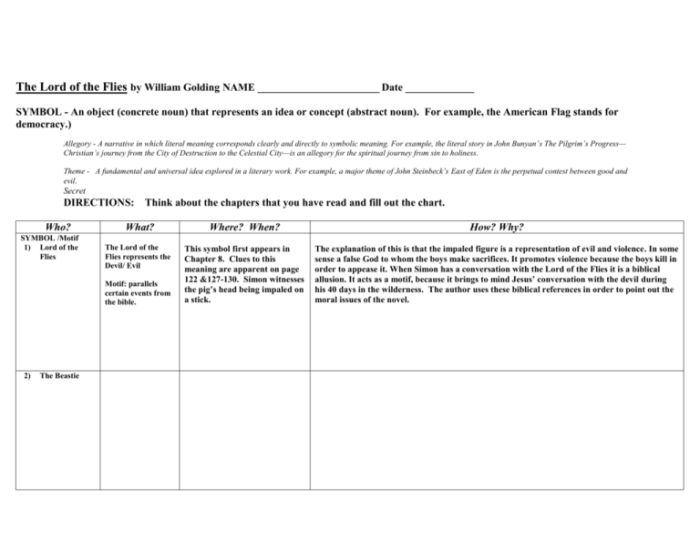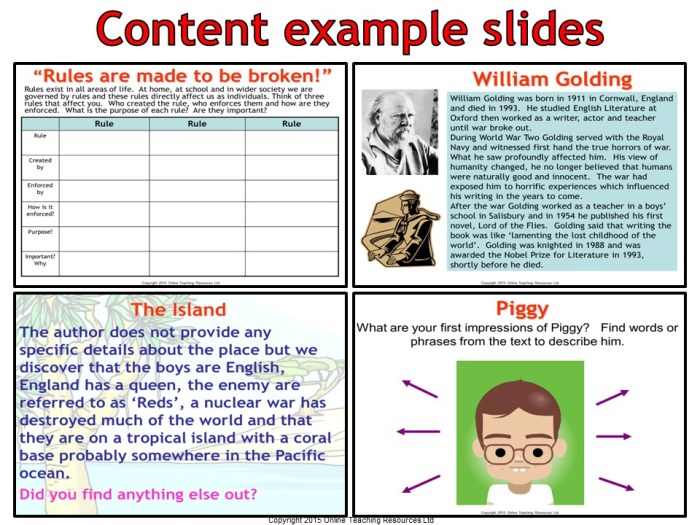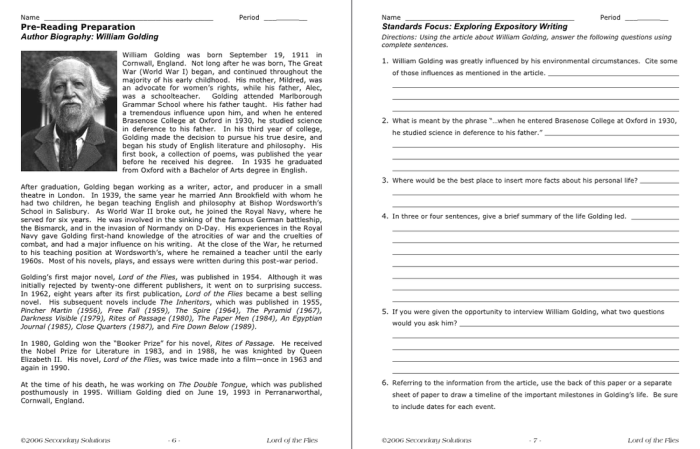Embark on a literary exploration with lord of the flies worksheet answers, a comprehensive guide that delves into the profound themes and characters of William Golding’s classic novel, Lord of the Flies. This in-depth analysis unravels the complexities of human nature, the struggle between savagery and civilization, and the profound impact of fear and power.
Through a detailed examination of the novel’s plot, characters, and symbolism, this guide provides a comprehensive understanding of the timeless lessons embedded within Lord of the Flies, offering valuable insights into the human condition and the enduring power of literature.
Introduction to “Lord of the Flies”

Lord of the Fliesis a novel by William Golding that explores the themes of savagery, civilization, and the nature of humanity. It tells the story of a group of British boys who are stranded on a desert island after their plane crashes. Initially, the boys attempt to create a civilized society, but as time goes on, they descend into savagery and violence.
The main characters in the novel are Ralph, Piggy, Jack, and Simon. Ralph is a natural leader who tries to maintain order and civilization on the island. Piggy is an intelligent and overweight boy who is often ridiculed by the other boys.
Jack is a charismatic and ruthless leader who represents the savage side of human nature. Simon is a spiritual and intuitive boy who represents the hope for redemption.
Plot Overview
The novel begins with the boys’ plane crashing on the island. The boys are initially excited to be free from the rules of adults, but they soon realize that they must create their own society. Ralph is elected as the leader of the group, and he tries to establish a system of rules and order.
However, Jack and his followers begin to challenge Ralph’s authority, and the boys soon divide into two factions: the hunters, led by Jack, and the civilized boys, led by Ralph.
As the boys spend more time on the island, they become increasingly savage. They begin to hunt and kill the island’s animals, and they even turn on each other. Ralph and Piggy are eventually killed by Jack and his followers, and the island is left in ruins.
Themes
Lord of the Fliesexplores a number of themes, including the savagery of human nature, the importance of civilization, and the power of hope. The novel shows that even the most civilized of people can be capable of great violence and cruelty, and that it is only through the power of hope that we can overcome our savage instincts.
Themes in “Lord of the Flies”
William Golding’s “Lord of the Flies” explores profound themes that resonate with human nature and the complexities of society. The novel delves into the innate savagery within humans, the fragility of civilization, the dynamics of power and leadership, and the paralyzing effects of fear.
Savagery vs. Civilization
A central theme in “Lord of the Flies” is the dichotomy between savagery and civilization. When the boys are stranded on the island, they initially attempt to maintain a semblance of order and follow rules. However, as time passes, their primal instincts take over, and they succumb to violence and chaos.
The novel suggests that civilization is a fragile construct that can easily be eroded when the constraints of society are removed.
Power and Leadership
The novel also examines the dynamics of power and leadership. Ralph, the initially elected leader, represents the forces of order and reason. However, his authority is challenged by Jack, who embodies the savage instincts of the group. The struggle between Ralph and Jack highlights the complexities of leadership and the dangers of unchecked power.
Fear
Fear is a pervasive force in “Lord of the Flies.” The boys’ fear of the unknown, symbolized by the “beast,” drives them to commit unspeakable acts of violence. Fear distorts their perceptions and leads them to turn against one another.
The novel suggests that fear can be a powerful and destructive force that can undermine even the best of intentions.
Character Analysis in “Lord of the Flies”

William Golding’s “Lord of the Flies” explores the themes of civilization versus savagery through the characters of Ralph, Jack, and Piggy. Each character represents a different aspect of human nature, and their interactions reveal the complexities of human behavior.
Ralph
Ralph is the elected leader of the boys on the island. He represents the forces of civilization and order. He is intelligent, fair, and compassionate, and he believes in the importance of rules and cooperation. Ralph’s leadership is challenged by Jack, who represents the forces of savagery and violence.
Jack
Jack is the leader of the hunters. He is strong, charismatic, and ruthless. He believes in the power of violence and domination, and he is willing to use fear and intimidation to control the other boys. Jack’s descent into savagery is gradual, but it is ultimately complete.
By the end of the novel, he has become a savage tyrant who is willing to kill to maintain his power.
Piggy
Piggy is the intellectual of the group. He is overweight and asthmatic, but he is also intelligent and resourceful. Piggy represents the voice of reason and logic, but he is often ignored or ridiculed by the other boys. Piggy’s death at the hands of Jack’s tribe is a turning point in the novel, and it symbolizes the triumph of savagery over civilization.
Symbolism in “Lord of the Flies”: Lord Of The Flies Worksheet Answers

Symbolism plays a pivotal role in “Lord of the Flies,” enriching the novel’s themes and character development.
The Conch Shell
The conch shell symbolizes order, civilization, and the rule of law. Its sound calls the boys to assemblies and represents their collective authority. As the shell cracks and breaks, so too does their fragile society.
The Island
The island itself is a microcosm of the world, representing both the beauty and savagery of human nature. Its lush vegetation and abundant resources provide sustenance, while its hidden dangers and isolation foster fear and conflict.
Fire
Fire is a complex symbol with multiple meanings. It represents both the transformative power of civilization and the destructive force of chaos. The boys’ struggle to control fire reflects their own internal battles between reason and instinct.
Literary Devices in “Lord of the Flies”

“Lord of the Flies” by William Golding is a complex and thought-provoking novel that explores the themes of civilization and savagery. Golding uses a variety of literary devices to create a vivid and immersive world for the reader. These devices include foreshadowing, irony, and imagery.
Foreshadowing
Foreshadowing is a literary device that hints at events that will happen later in the story. In “Lord of the Flies,” there are several instances of foreshadowing that hint at the eventual descent of the boys into savagery. For example, when the boys first arrive on the island, they find a conch shell that they use to call meetings.
However, the conch is eventually broken, symbolizing the loss of order and civilization on the island.
Irony, Lord of the flies worksheet answers
Irony is a literary device that creates a contrast between what is expected and what actually happens. In “Lord of the Flies,” there are several instances of irony that highlight the boys’ descent into savagery. For example, the boys initially believe that they will be able to create a utopian society on the island.
However, they quickly descend into chaos and violence.
Imagery and Figurative Language
Imagery and figurative language are literary devices that create vivid images and impressions in the reader’s mind. In “Lord of the Flies,” Golding uses imagery and figurative language to create a sense of atmosphere and to convey the boys’ emotional states.
For example, Golding uses the image of the island as a microcosm of the world to explore the themes of civilization and savagery.
Film Adaptations of “Lord of the Flies”
The novel “Lord of the Flies” by William Golding has been adapted into two notable film versions: the 1963 version directed by Peter Brook and the 1990 version directed by Harry Hook. While both adaptations share the core narrative of the novel, they differ in their interpretations, cinematic techniques, and overall impact.
1963 Adaptation
The 1963 adaptation is considered a classic of British cinema. Directed by Peter Brook, the film features a cast of young, non-professional actors who deliver remarkably authentic performances. The film’s black-and-white cinematography creates a stark and atmospheric setting, emphasizing the isolation and vulnerability of the boys.
Strengths:
- Realistic and immersive performances
- Stunning black-and-white cinematography
- Faithful adaptation of the novel’s plot and themes
Weaknesses:
- Limited budget and resources
- Some critics argue that the film’s ending is too abrupt
1990 Adaptation
The 1990 adaptation, directed by Harry Hook, features a more polished and commercial approach. The film boasts a cast of well-known young actors, including Balthazar Getty and Chris Furrh. The cinematography is more colorful and vibrant, giving the film a more accessible and mainstream appeal.
Strengths:
- Visually stunning cinematography
- Strong performances from the young cast
- More accessible and appealing to a wider audience
Weaknesses:
- Some critics argue that the film is too polished and loses the novel’s raw and unsettling nature
- The ending is significantly altered from the novel
Differences from the Book
Both film adaptations make certain changes to the novel’s plot and characters. The 1963 adaptation is generally considered more faithful to the book, while the 1990 adaptation takes more liberties with the source material. Notable Differences:
- The 1963 adaptation includes a scene where the boys discover a dead parachutist, which is not in the novel.
- The 1990 adaptation introduces a new character, a female pilot who becomes a symbol of hope for the boys.
- The ending of the 1990 adaptation is significantly altered, with the boys being rescued by a passing ship rather than being left to their own devices.
FAQ Overview
What is the central conflict in Lord of the Flies?
The central conflict in Lord of the Flies is the struggle between the forces of civilization and savagery within the group of stranded boys.
Who is the protagonist of Lord of the Flies?
Ralph is the protagonist of Lord of the Flies, representing the forces of civilization and order.
What is the significance of the conch shell in Lord of the Flies?
The conch shell represents order, authority, and the rule of law.